Dell XPS 12 Review: A Jack of All Trades Flipscreen Ultrabook
by Jarred Walton on February 22, 2013 2:13 AM EST- Posted in
- Laptops
- Dell
- XPS
- Intel Insider
- Ultraportable
- hybrids
- Ultrabook
Dell XPS 12 Laptop Performance Summary
We’re taking the same approach to benchmarks that we used with the Acer S7 and Surface Pro reviews—which is to say, we’ll use all of our typical laptop benchmarks along with some of the tablet-centric benchmarks to round things out. Performance as you’d expect is basically on par with other Core i7 ULV offerings (e.g. Acer S7), so faster than the Surface Pro, substantially faster than any non-Core products, but worse battery life than ARM offerings. Given the size and weight, this is much more a part of the laptop with a touchscreen crowd as opposed to being a tablet with laptop aspects, so our primary focus will be on how it compares with other laptops. Here’s the quick overview of the base components for the various laptops we’re including. Note that at present, only the XPS 12, Acer S7, Surface Pro, and Vizio CT15 were tested with Windows 8; the rest were running Windows 7.
| Laptop Configuration Overview | ||||
| Laptop | CPU | Graphics | Storage | Battery |
| Acer Aspire S7-391-9886 | Intel i7-3517U | HD4000 | 2x128GB SSD | 35Wh |
| Apple MacBook Air 13 (Mid-2012) | Intel i5-3427U | HD4000 | 256GB SSD | 50Wh |
| ASUS Zenbook Prime UX31A-DB71 | Intel i7-3517U | HD4000 | 256GB SSD | 50Wh |
| Dell XPS 12 | Intel i7-3517U | HD4000 | 256GB SSD | 47Wh |
| Dell XPS 13 | Intel i7-2637M | HD3000 | 256GB SSD | 47Wh |
| HP Envy 14 Spectre | Intel i7-3667U | HD4000 | 2x128GB SSDs | 56Wh |
| HP Folio 13 | Intel i5-2467M | HD3000 | 128GB SSD | 60Wh |
| Intel IVB Ultrabook Prototype | Intel i5-3427U | HD4000 | 240GB SSD | 47Wh |
| Microsoft Surface Pro | Intel i5-3317U | HD4000 | 128GB | 42Wh |
| Toshiba Satellite U845-S406 | Intel i5-3317U | HD4000 | 500+32GB Hybrid | 54Wh |
| Toshiba Satellite U845W-S410 | Intel i5-3317U | HD4000 | 500+32GB Hybrid | 54Wh |
| VizioCT15 | Intel i7-3517U | HD4000 | 256GB SSD | 52Wh |
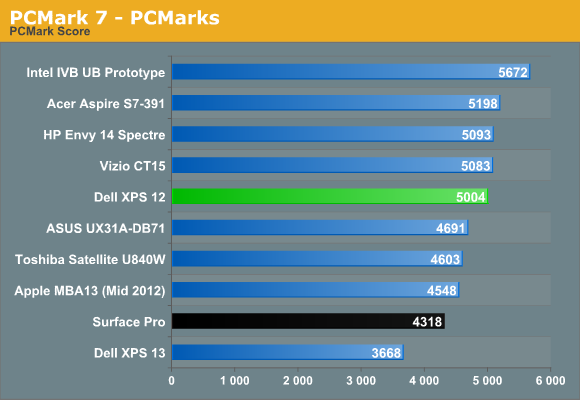
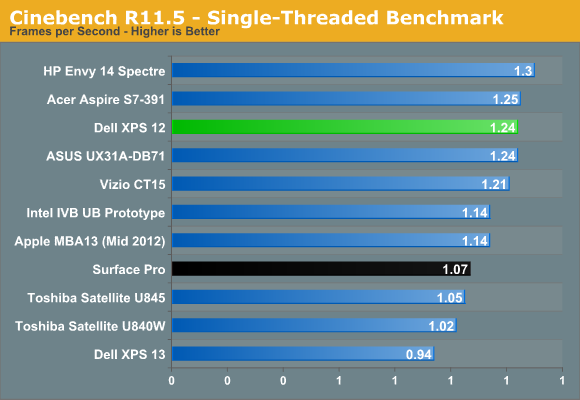
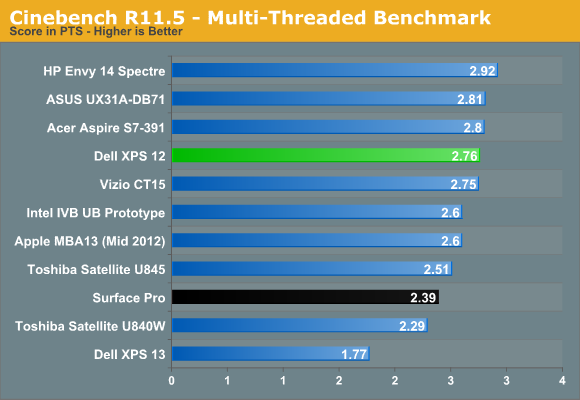

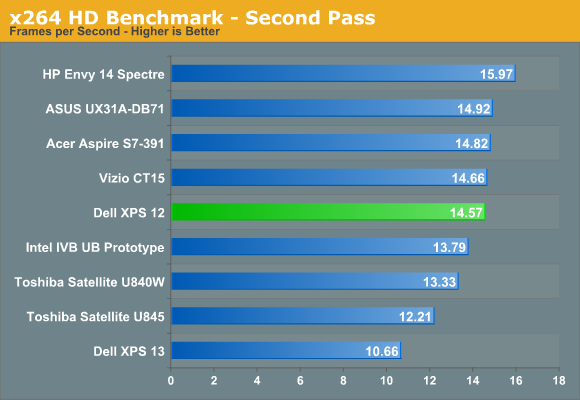
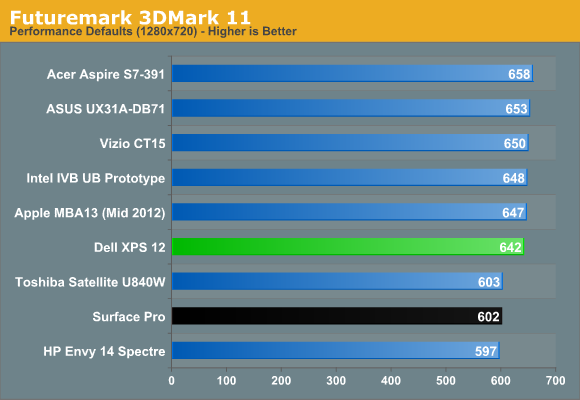
There aren’t really any surprises here; the XPS 12 performs right about where we’d expect. Acer’s S7 does come in slightly ahead in most benchmarks, which is interesting considering it’s thinner and thus cooling the chip (and enabling higher Turbo Boost clocks) should in theory be more difficult, but clearly that’s not the case. Whether it’s a lack of fine tuning for performance, minor differences in other components, or prioritizing quiet over fast, unless you’re really concerned about a difference of a few percent all of the i7-3517U Ultrabooks perform about the same. Actually, that’s not quite true, as Windows 7 models seem to hold a slight performance advantage in several tests as well (particularly battery life, which we’ll get to in a moment).










59 Comments
View All Comments
Visual - Friday, February 22, 2013 - link
"(Note that the Surface Pro also comes with a pen, so that's probably a $50 add-on.)"Are you joking, or are you really that clueless?
It is not just the pen that is added there, it is an active digitizer layer added to the screen that costs at least $150. And it is worth every penny. No sane person would want a tablet without an active digitizer after having experienced using one for a time.
althaz - Friday, February 22, 2013 - link
Whilst I would not buy a tablet without a digitizer and pen, it's a bit of a stretch to say that no sane person would want one without it.JarredWalton - Friday, February 22, 2013 - link
$150 isn't what it would cost to add, but they might add that much to the price. Just like upgrading from a $90 quality TN panel to a $150 IPS panel often adds $300 to the price.redmist77 - Friday, February 22, 2013 - link
The flip screen is very sturdy (over-engineered if anything), works flawlessly and gives the best of both worlds. It's a bit strange to see the armchair experts in these comments passing extreme judgements despite clearly having zero experience with the product.This a fantastic Ultrabook with one of the best capacitive 1080 touch screens on the market that happens to fold into a tablet. Exactly what I wanted. I also *much* prefer glossy screens that add real depth and polish to on-screen images.
I'm sure pen support would be nice but the pen screens I've used aren't anywhere near as responsive, sensitive or accurate as this one.
My only minor gripe with the XPS12 is the poor color gamut.
Sazar - Friday, February 22, 2013 - link
I agree with most of your sentiments. I think I also lucked out on the color gamut because with very little tweaking, color's look great on my screen. In the interest of full disclosure however, I am partially color-blind :)My only concern has been a bug that is either tied to the panel, or Windows 8, where the touch-screen simply stops working. The only fix is to wake it after putting the system to sleep, or a reboot. Given how quickly it resumes or reboots, it doesn't take long to resolve, but it's annoying when it happens (about once or twice a month thus far).
There are new drivers for the touch pad as well that make it a lot better.
As an aside, for those interested, the frame is sturdy enough that you can flip the screen and then use the device in "tent" mode, like the Yoga. Works brilliantly.
alexvoda - Friday, February 22, 2013 - link
Please get Lenovo to send you a Thinkpad Helix review unit.I believe the Helix has the best combination of features and form factor with the only downside being the price.
It can be used in more ways than any other simmilar device.
IIRC the Helix is the only dockable tablet that an be docked in two ways giving it the use cases of both "flexible" laptops (Dell XPS12, Lenovo Yoga) and detachable tablets (Asus, Acer, Samsung).
rwei - Friday, February 22, 2013 - link
^ this.After using an x120e more and more while traveling, I'm a solid convert to the TrackPoint. It seems like the obvious solution for putting a pointing interface into a space-constrained device, particularly when complemented with a touchscreen (which obviates the need for many gestures).
Also love the option of just having the tablet on its own, which I'd probably do for my day-to-day use commuting in a subway.
Then, on a plane, I can put it in stand/combined tablet mode for battery life.
Then, when work inevitably gives me a task to work on during a trip, I can pop on the dock as a keyboard and deal with that.
All within 3.3lbs total + charger, barely more than the x120e.
Optionality is valuable $$$
damianrobertjones - Friday, February 22, 2013 - link
"RAM is soldered onto motherboard"- Slapping in Vengeance performance ram REALLY does help improve the HD4000 so it's a DAMN shame.
ssj3gohan - Friday, February 22, 2013 - link
Really? I was under the impression that intel IGPs didn't care much for RAM bandwidth, it's the AMD chips that really suffer when using slower (higher latency) RAM.But I'm not really into this stuff, could be wrong here.
Alexvrb - Saturday, February 23, 2013 - link
You're not entirely wrong. Intel's IGP doesn't scale as well or as far as AMD's integrated graphics (especially A8 and A10 APUs). This is especially evident in Intel's low-voltage variants (such as the one in this model), which employ lower base and sustained turbo clocks than their higher-power brethren (despite using the same name). With that being said, they could have benefited somewhat from using DDR3 1600 even without a full-factory-power HD4000.However, I'd bet that using slower memory is actually quite intentional. I suspect that they're using 1.25V DDR3U 1333 instead of 1.35V DDR3L. During development, they must have determined the hit to performance was not enough to outweigh using less power hungry memory - at least for this particular combination.